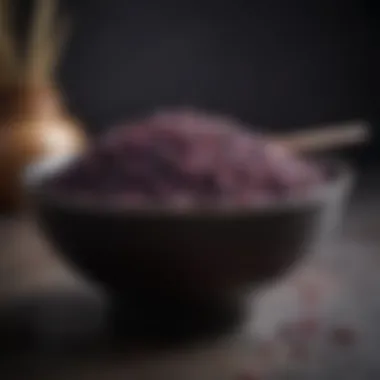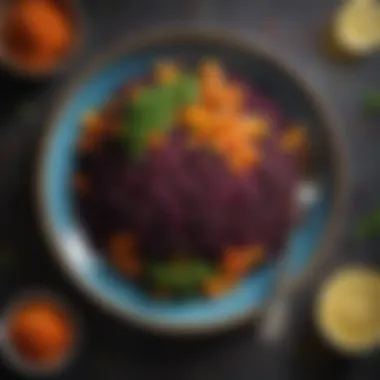Unveiling the Nutritional Power of Forbidden Rice


Intro
Forbidden rice, an ancient grain, piques interest for its unique taste and impressive nutritional profile. Often regarded as a superfood, many are unsure of how to incorporate it within their daily diet or understand the benefits it offers. The focus of this article is to examine not only how to prepare this distinctive rice but also its overall health benefits.
As consumers face the demands of modern life, it’s rare to find uncomplicated yet nutritionally rich foods. The pursuit of healthier meal solutions leads many to probable choices, thus making an understanding of forbidden rice vital.
Recipe Overview
Creative Name: Forbidden Risotto with Fresh Veggies
Yields: 4 portions
Preparation and Cooking Time: 30 minutes prep, 20 minutes cook
Difficulty: Medium
Main Ingredients
- 1 cup forbidden rice
- 4 cups vegetable broth
- 1 small onion, diced
- 1 bell pepper, diced
- 2 cloves garlic, minced
- 1 cup asparagus, chopped
- 1 tablespoon olive oil
- Salt and pepper to taste
Step-by-Step Instructions
- Prep ingredients: Wash the forbidden rice under cold water until the water runs clear. Chop the onion, bell pepper, asparagus, and mince the garlic.
- Cook veggies: In a large pot, heat the olive oil over medium heat. Add the diced onion, bell pepper, and garlic, sauté until the onion is translucent.
- Add rice and simmer: Stir in the forbidden rice for 1-2 minutes until slightly toasted. Pour the vegetable broth into the pan, raise the heat to bring it to a low simmer, and cover the pot.
- Cook: Simmer for about 20 minutes or until the rice is cooked through and the broth is mostly absorbed. Add the asparagus, cooking uncovered for an additional 3-5 minutes.
- Serve: Remove from heat, season with salt and pepper, and enjoy!
Time-saving Strategies
- Consider using pre-chopped vegetables for added efficiency.
- Cook larger batches of forbidden rice to save time for future meals by reheating.
Nutritional Information
- Calories per Portion: Approximately 250 kcal
- Breakdown:
- Proteins: 6g
- Fats: 7g
- Carbohydrates: 40g
Nutrients of Note
- Rich in antioxidants and iron
- High in fiber, promoting digestive health
Quick Cooking Tips
- An electric pressure cooker can expedite the cooking time significantly.
- While the rice cooks, utilize that time to prepare a side salad or other accompaniments to your meal.


Related Recipes & Variations
- Pair with grilled chicken or seafood for extra protein.
- Explore vegan and gluten-free variations based on ingredient swaps—experiment with different vegetables.
Experience of kitchen creativity gives rise to personal flavors. Adapting recipes to suit unique dietary preferences can be an enjoyable challenge.
Cooking with forbidden rice is not just about its flavor; it signifies a step toward healthier eating habits. As you embrace this rich grain, you delve into a world where nutrition meets culinary delight.
Prolusion to Forbidden Rice
Forbidden rice, often recognized for its distinct dark hue, carries an importance that transcends mere culinary novelty. This grain has historical roots and endures in modern diets, shedding light on genetic trends and ancient practices in agriculture. By pondering over the journey of forbidden rice, one can appreciate how its celebrated attributes serve as a link to cultural heritage and provide valuable nutritional benefits.
Origin and Historical Significance
Forbidden rice is underlined by a plethora of intriguing historical facts. Native to China, this grain was once termed
Nutritional Profile of Whole Foods Forbidden Rice
Understanding the nutritional profile of Whole Foods Forbidden Rice helps to appreciate its significance within a balanced diet. This unique grain offers a distinct combination of essential nutrients that can enhance health and well-being. Moreover, realizing how it stacks against other grains highlights its place in modern eating habits.
Comparative Analysis with Other Grains
When comparing forbidden rice to more common varieties such as white or brown rice, several notable differences arise.
- Antioxidant Content: Forbidden rice is rich in anthocyanins, the same compounds that give blueberries and blackberries their vibrant color. These antioxidants can combat oxidative stress in the body.
- Fiber: The whole grain form of forbidden rice provides more dietary fiber compared to white rice, which has been stripped of its bran and germ.
- Protein: It tends to have a higher protein content compared to standard white rice, facilitating improved digestion during digestion and aiding in muscle repair after physical activity.
- Gluten-Free: Like other rice varieties, forbidden rice is naturally gluten-free, making it suitable for individuals with gluten sensitivities.
Thus, this comparison is essential to grasp its nutritious value in today’s health-conscious world waiting for dietary diversity.
Vitamins and Minerals Present
Forbidden rice does not only serve as a carbohydrate source; it is also packed with a variety of vitamins and minerals.
- Iron: Necessary for transporting oxygen in your blood, iron is abundant in forbidden rice, assisting in nutrient delivery throughout the body.
- Vitamin E: This antioxidant vitamin promotes healthy skin and immune function.
- Magnesium: Known for its benefits in muscle and nerve function, magnesium is also present in substantial amount in forbidden rice.
- Zinc: Important for immune questioning and wound healing, minerals like zinc keep your body functioning optimally.
Including forbidden rice in meals allows individuals to gain these essential nutrients while avoiding common deficiencies seen with less versatile grains.
Health Benefits Related to Consumption
Aside from its appealing flavor and texture, the consumption of forbidden rice potentially leads to various health benefits:
- Weight Management: The fiber content contributes to a feeling of fullness, which may aid in controlling appetite and achieving weight loss goals.
- Improved Digestive Health: The dietary fiber in forbidden rice facilitates regular bowel movement and overall gut health.
- Potential Heart Health: Because of its rich antioxidant profile, frequent consumption may benefit heart health by reducing inflammation and lowering blood pressure.
- Stabilizing Blood Sugar Levels: Compared to many refined grains, forbidden rice may help prevent spikes in blood sugar due to its fiber and protein content.


Overall, the combination of these elements underlines the unique benefits that Whole Foods Forbidden Rice can offer. Understanding its nutritional profile guides people in making informed dietary choices, supporting health goals, and enriching their meals.
Culinary Applications of Forbidden Rice
The culinary applications of forbidden rice are diverse and integral to understanding its versatility in modern kitchens. This grain is not just an exotic addition; it offers a myriad of health benefits and contributes unique flavors and textures to various dishes. By exploring its uses in a culinary context, one can fully appreciate how forbidden rice can elevate nutritious meals while catering to contemporary dietary trends.
Cooking Techniques and Preparation Methods
Cooking techniques for forbidden rice often resemble those of other whole grains, yet some specific methods help fully unlock its nutritional potential. Firstly, it is essential to rinse forbidden rice thoroughly under cold water. This step removes excess starch, which can lead to a gummy texture during cooking. Cook in a ratio of approximately 1 cup of rice to 2 cups of water for optimal results.
When cooking, consider bringing the water to a boil initially, then reducing to a simmer and covering it for about 30-40 minutes. Resist the urge to lift the lid too soon; this can disturb the steam balance essential for the perfect texture. Let the rice stand after cooking, allowing it to firm up and distribute moisture evenly.
Recipes Incorporating Forbidden Rice
Salads
Salads with forbidden rice provide an interesting twist on the conventional leafy greens dish. The grain introduces a striking color contrast and offers a chewy, satisfying texture, enhancing the meal's overall appeal. Its nutty flavor complements a variety of vegetables, making it a popular choice in summertime gatherings.
Recipes can highlight the grain by pairing it with ingredients like cherry tomatoes, cucumbers, and a light vinaigrette. This not only adds flavor but also offers essential nutrients. A salad featuring forbidden rice ensures the meal is filling, serving as a base or star ingredient for health-conscious eaters.
Main Dishes
Forbidden rice can create substantial main dishes that satisfy both taste and nutrition. For instance, incorporating it into stir-fries augments the dish’s nutritional profile, blending beautifully with proteins and variety of vegetables.
The unique characteristic of forbidden rice lies in its ability to absorb the flavors of other ingredients while maintaining its distinct taste. It can be added to curries or served as a bed for grilled vegetables, balancing the plate with its earthy undertones. With culinary suitability for vegan, vegetarian, and omnivorous diets, these dishes find a place in nearly any meal plan.
Desserts
Using forbidden rice into dessert recipes represents an imaginative leap from the conventional. Various dessert concepts, such as rice puddings, showcase the grain's ability to blend with sweet flavors. Preparing such desserts can yield textures that contrast beautifully—with the chewiness of the rice against, for instance, creamy coconut milk or citrus-infused elements.
This approach offers a healthier alternative to classic dessert options, increasing dietary fiber and nutrients, making it a standout choice for guests who desire less-refined sugar and calorie-loaded inti-mates. Desserts featuring forbidden rice resonate with those looking to elevate their meals healthfully.
Pairing Forbidden Rice with Other Ingredients
Pairing forbidden rice with other ingredients can enhance both flavor profiles and nutritional value. Consider combining it with meats like chicken or beef, which provide protein, accompanying the richness of forbidden rice.
Vegetables such as bell peppers, spinach, and carrots can add vibrancy and additional fibers. Furthermore, consider legumes like edamame or chick peas, which pair not only from a taste standpoint but also amplify the protein content—formulating a meal both extensive and health-friendly. Ultimately, the versatility in pairing makes forbidden rice a prime candidate for creative meal planning.
"Forbidden rice is not just a grain but a canvas for culinary artistry, enhancing everyday meals with its charm."
Choosing Quality Forbidden Rice


Selecting high-quality forbidden rice is essential for optimizing its nutritional benefits and culinary properties. Not all rice is created equal, and several factors can influence the taste, texture, and overall quality of the grain. For cooking enthusiasts, understanding how to choose the best variety can make a significant difference in meal preparation and enjoyment.
What to Look for in Quality Grains
When evaluating grains, several characteristics should be considered. Examining the color and fragrance of forbidden rice can imply its quality. Here are a few aspects to look for:
- Color: Authentic forbidden rice typically has a deep, rich black or dark purple hue. If the grain appears dull or grayish, it could be a sign of aging or lower quality.
- Fragrance: A fresh batch emits a nutty aroma. Stale or old rice may have little to no scent, reflecting diminished quality.
- Shape and Size: High-quality forbidden rice kernels are generally elongated and plump. Look for uniformity in size for even cooking.
- Packaging: Choose rice that is packaged in a well-sealed bag to protect it from moisture. Check for clear labeling, including expiration dates and origin.
Addressing Common Misconceptions
Addressing misconceptions about forbidden rice is vital. By clarifying these issues, consumers can make informed decisions about including this grain in their diets. Improper views can lead to missed opportunities for health benefits. Also, misunderstandings can create unnecessary obstacles for those seeking nutritious alternatives.
Gluten-Free Status
Many people assume that all grains are gluten-containing. This is not always true. Forbidden rice is actually gluten-free. Knowing this is essential, especially for those with celiac disease or gluten sensitivity.
Incorporating gluten-free foods does not mean sacrificing nutrition. Forbidden rice invalidates the idea that nutritious options are limited. It is versatile and can replace many gluten-containing grains in dishes. This makes it suitable for a variety of diets. Therefore, when you consume forbidden rice, you can enjoy its flavor without concern for gluten-related issues.
Many dietary choices are made better when there is clear understanding. Without misconceptions, health can be prioritized more efficiently.
Nutritional Myth Busting
Another common misconception surrounds the nutritional content of forbidden rice. It is often thought of as a “less nutritious” option compared to its white counterpart. This is inaccurate. In reality, forbidden rice boasts higher levels of antioxidants and nutrients, particularly anthocyanins. These compounds support overall health and wellness.
Some may believe that eating darker grains will not be as satisfying as white rice. However, forbidden rice can fill and satisfy just as well. Its nutty flavor and chewy texture might even enhance meals. Recognition of its nutritional density offers value, as it has benefits beyond mere calories.
Therefore, it is essential to dispel common myths regarding the limitations of forbidden rice. Making it a regular ingredient in one’s diet can be highly beneficial. Parents should introduce it to children and even as a separate family staple.
People are often misled by buzzwords or social trends surrounding diets. Proper education can illuminate the path to understanding true food values. Thus, embracing forbidden rice makes a world of difference, elevating culinary enjoyment judiciously.
Culmination
The integration of forbidden rice into beleaguered lifestyles signifies much more than just a culinary trend; it represents a balanced approach to nutrition that can cater to health-conscious individuals. Understanding the merits of this unusual grain allows one to make informed decisions that can impact not only personal health but also culinary creativity.
The Value of Integrating Forbidden Rice into Everyday Meals
Incorporating forbidden rice into daily meals comes with multiple benefits that appeal to both taste and nutrition. Firstly, forbidden rice boasts a complex flavor profile, combining nuttiness with slight earthiness. This complexity can elevate ordinary dishes, adding dimension and richness.
Secondly, this whole grain is rich in antioxidants. The anthocyanins that provide its deep, dark hue serve to combat oxidative stress in the body, potentially reducing the risk of chronic disease.
Thirdly, it is an excellent source of dietary fiber. Fiber is important for digestive health, aiding in regularity and contributing to a feeling of satiety. This characteristic can help manage weight, as incorporating fibrous foods typically leads to consuming fewer calories overall.
Considerations about incorporating forbidden rice involve understanding its preparation. Unlike more common grains, this rice requires a different cooking approach, often demanding to be rinsed and soaked before cooking to achieve the right texture. Targeting these preparatory methods can ensure a rewarding culinary experience.
It is but also necessary to learn how to pair forbidden rice with other nutritious ingredients. For instance, pairing it with lean proteins like chicken or interesting sources of plant-based protein can create a well-rounded meal. Notably, combining it with vegetables or legumes can offer a spectrum of nutrients and create vibrant dishes.
"Food is not just sustenance. It is a canvas to reflect health, culture, and creativity. Rethinking grain choices can fundamentally evolve one’s culinary experience."







